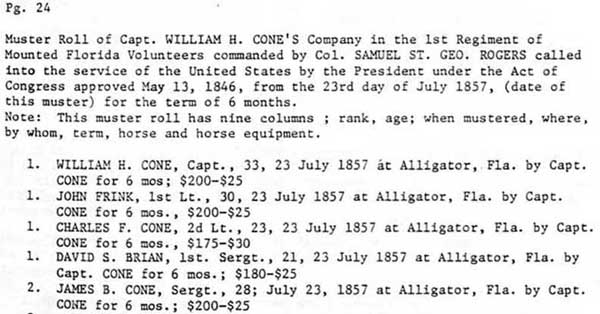

Four Cone brothers fought in the Battle of Olustee:
From the 1857 Muster Rolls of William's company of mounted volunteers (Seminole War), three of the brothers are described as:


Captain William Haddock Cone was the father of Fred F. Cone who was the governor of Florida during 1937 to 1941. William Haddock Cone has been confused with his father, William Henry Cone. William Henry Cone married Sarah Haddock of Nassau County. They lived in Camden County, Georgia from 1810 to 1835 then moved to upper Columbia County, Florida near the small town of Benton. William Henry Cone, a Whig, was a Georgia state legislator in Camden County prior to 1835, a Florida Territorial legislator from Columbia County during 1841-1842, and Florida State Senator (13th District) in 1854 and 1856. William Henry fought in the 1st and 2nd Seminole Wars and taught his sons the rudiments of swamp guerilla warfare. He was a guide for Col. Newnan in a campaign (1812-1814) that included a battle southeast of Gainesville, Florida. William Henry died in 1857.
In 1857, three of his sons - William, Charles and James Barnard - participated in a raid during the 3rd Seminole War that did some damage to Seminole Chief Billy Bowlegs.
"... Captain W.H. Cone, with 115 men, surprised a party of Indians, killed one warrior, and captured eighteen women and children along with large quantities of provisions. No Americans were killed in this encounter but many of the men came out of the swamps ill and exhausted." - from The Florida Wars, by Virginia B. Peters, ISBN 0-20801-7194
"In November, Captain William Cone and a force of militiamen mostly from Columbia and Alachua Counties, moved into the area west of Okaloacoochee Swamp and south of Fort Doane and struck the first heavy blow felt by Billy Bowlegs and band. With experienced woodmen leading the way, the small force followed an Indian trail and discovered on November 19, 1857, a cluster of dwellings and some unforewarned Seminoles. The two guards put up a fight and were killed but the others, including the one wounded warrior, five women and thirteen children, were captured. Several nearby villages containing as many as forth dwellings and stores of corn, rice and pumpkins were destroyed. Proof that the Indians were from Bowleg's band was seen among the captured items fifty bushels of corn, one hundred bushels of rice, some oxen, and hoes and assorted items belonging to Billy Bowlegs - - a suit, an 1852 tintype showing Billy in Washington, a shotbag and a turban.
Heartened by their success, the militiamen pushed their way through the maze of cypress trees along the Okaloacoochee and were able to inflict more damage. On the day following the capture of the Seminoles, a field containing corn, pumpkins and rice was discovered and laid waste. It took much strength and endurance to wade through the waist deep water and push through the heavy growth of grass, trees and bushes. At night, the men climbed into trees and slept just a short distance above the water. The fatigue was so great that eighteen men found the struggle too much for them on the first day and on the following day, sixty-two were forced to turn back. The remained followed a trail along the river and discovered twelve sunken dugouts. Looking about they discovered a village and some unsuspecting Seminoles cooking their meal. A wild charge carried the soldiers into the cluster of homes and two Seminoles were killed in the melee. One old Seminole named Tigertail vowed that he would never leave Florida alive and although carefully watched, was able to steal, crush and devour a glass bottle at Punta Rassa. He had kept this word and died on the Florida sand.
Cone's raid was the first really effective blow struck at the well-concealed Mikasiuki band and the Seminoles vowed their revenge. They followed the militiamen along their return route to Depot Number One and attempted to ambush them, but without success. On November 26, a herd of horses grazing in Billy's garden situated about one mile's distance from Depot Number One was attacked by the Indians and thirty-six of the animals killed."- from The Billy Bowlegs War, 1856-58: The Final Stand of the Seminoles Against the Whites, by James W. Covington, 1982, ISBN 091312-2068
2nd Florida Cavalry
Battle of Olustee home page.
http://battleofolustee.org/